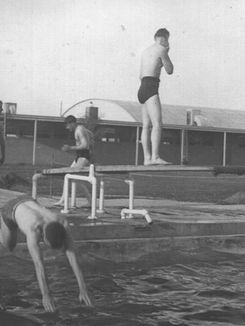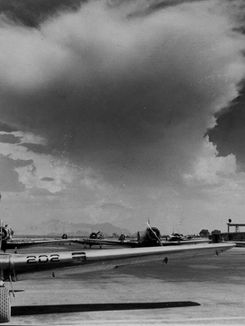
History of Mesa
The City of Mesa has a complex and rich history. From its prehistoric roots to today’s dynamic business and residential community, Mesa has seen it all. The first prehistoric people to live in Mesa were the Hohokams who flourished in the valley for over 1,500 years. They were farmers and canal builders who lived in large communities of up to 500 people. They are best remembered for their construction of a large network of irrigation canals. The prehistoric Hohokam canals were incredible works of labor and engineering. The hand dug system, irrigated over 110,000 acres and was the largest in the prehistoric world.
The Hohokam irrigation system transformed the soils of the Salt River Valley, allowing them to grow abundant crops for their use and for trade. The Hohokam traded cotton cloth for seashells from the Gulf of California and for exotic birds from the Yucatan. Eventually, the Hohokam began to move from the area as they experienced a period of overpopulation, nutritional stress, and warfare. They disappeared from the area by around 1450 and there has been no explanation as to where they went.
Between the time of the decline of the Hohokam culture in the 15th century and the mid 1800’s, no long-term settlement existed in the Mesa area. Intermittent conflicts between the Pima and Maricopa along the Gila River and the Yavapai and the Apaches in the Salt River Valley, ensured that the region would not be settled during that time. It was not until the establishment of Fort McDowell by the United States Army on 1865 that permanent settlement was created in the area. The effectiveness of the Fort helped to pave the way for Anglo settlements in Phoenix, Tempe, and Mesa.
1877, the first pioneers settled the Mesa Area. Sent from Utah by Brigham Young, the “Utah Company” was originally sent to establish “stations on the road” supporting the Church’s expansion into Mexico. They built their first homes and businesses in what is known as Lehi, now in Northern Mesa. The rich soil near the Salt River was perfect for growing crops. The Pima and Maricopa living in the area helped the pioneers carve out a life in the desert. Additionally, Tempe founder Charles Hayden loaned money to the company and other resources to help the colony create a community.
The second group of Mormon settlers to arrive in the area was known as the Mesa Company. Arriving on 1878, this group distinguished themselves by settling on the mesa top and by clearing ancient Native American canals so that water could be diverted to the higher ground. By the early 1880’s, nearly 300 people had settled in the Mesa area, most living within one square mile of downtown.
Cultural, diversity has been a part of Mesa’s history from the earliest days of the settlement. The people who made up the companies of the Mormon pioneers, white Europeans in terms of ethic background, and the Native American people already living in the area were soon joined by other immigrants including African Americans, Chinese, Mexican, Japanese, and Arabs, came to farm, to open businesses, and to work construction. The town saw a major boom as construction of nearby Roosevelt Dam brought ample opportunity for work and leisure in town.
Agriculture was the foundation of the Mesa economy until after World War II. Dairy farming and stock-raising were an ever-increasing sector of the agricultural economy. Much of the Mesa workforce was employed in agricultural-related industries. Surprisingly, agriculture was an important factor in attracting tourists to Mesa by the early 20th century. The Roosevelt Dam became a main attraction along with prehistoric ruins including the Hohokam ceremonial site Sce:dagĭ Mu:val Va’aki.
In the years following WWII, the economy underwent a major transformation. Many factors were at work, including the mechanization of farming, the availability of affordable air conditioning units that made living year-round in the desert comfortable, the advent of the cold war, and the rising popularity of the Old West. The economy began to change from agriculture to one based on the high tech, tourism, and service industries.
Over the years, the little town that began as a “station on the road,” continued to thrive. The population doubled every decade except during the 1920’s, and the city soon far outgrew its original one-square-mile boundary. The road has not always been easy for the citizens of Mesa. The city has endured epidemics, two major depressions, and has sent its sons and daughters off to two World Wars. Extreme heat, floods, and drought have also tested the spirit of its people.
Unfortunately prejudice and racism have also impacted nearly all of Mesa’s diverse communities to varying degrees over the years. African American residents felt the impact of this more than any other group. Limited as to where they could buy homes and where they could send their children to school, black Americans had to work hard for even their basic rights. Until desegregation took place in the 1950’s, many minority citizens found themselves segregated in parks, swimming pools, movie theaters, dance halls, restaurants, and just about anywhere else local residents might congregate for business, play, and social activities. Arizona was also the site of relocation camps for many Japanese Americans during World War II. However, since the end of that war and the desegregation that followed, ethnic minorities have made great strides. Their stories-good, bad, and in-between-are as much a part of Mesa as any that might be told.
In May 1979, the city was named an All American City by the National Municipal League. Mesa was honored for its efforts to address community problems through cooperation among citizens, schools, civic groups, and local governments, including the Salt River Pima-Maricopa Indian Community.
Today the city of Mesa is a thriving desert community bounded on all sides by smaller neighboring towns. The only other city in Central Arizona that is larger than Mesa is Phoenix. It is the 35th largest city in America and boasts a population of over 500,000.
Mesa was among the first in the region to recognize the importance of baseball as a community asset. Countless Major League Players came to Mesa to play ball and to take in the rejuvenating waters at the Buckhorn Baths. Mesa now boasts two teams and two stadiums, a first for any valley community. In addition, Mesa has attracted industry giants like Boeing, General Motors, and Tally Industries while developing the old Williams Air Force Base into a full-scale regional and commercial airport. In addition to boasting the largest community college in the nation, Mesa has attracted multiple educational institutions from around the nation have established college facilities in Mesa. The city is also a leader in producing a thriving cultural economy with multiple museums and the Mesa Arts Center.
Without a doubt, Mesa will continue to grow and create an identity of its own in the Salt River Valley for years to come.





